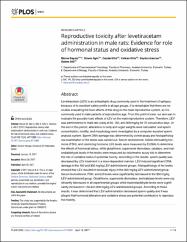Reproductive toxicity after levetiracetam administration in male rats: Evidence for role of hormonal status and oxidative stress

Göster/
Erişim
info:eu-repo/semantics/openAccessTarih
2017Yazar
Baysal, MerveIlgın, Sinem
Aydoğan Kılıç, Gözde
Kılıç, Volkan
Uçarcan, Şeyda
Atlı Eklioğlu, Özlem
Üst veri
Tüm öğe kaydını gösterÖzet
Levetiracetam (LEV) is an antiepileptic drug commonly used in the treatment of epilepsy because of its excellent safety profile in all age groups. It is remarkable that there are no studies evaluating the toxic effects of this drug on the male reproductive system, as it is commonly used in male patients of reproductive age. From this point of view, our aim was to evaluate the possible toxic effects of LEV on the male reproductive system. Therefore, LEV was administered to male rats orally at 50, 150, and 300 mg/kg for 70 consecutive days. At the end of this period, alterations to body and organ weights were calculated, and sperm concentration, motility, and morphology were investigated by a computer-assisted sperm analysis system. Sperm DNA damage was determined by comet assay and histopathological examination of the testes was carried out. Serum testosterone, follicle-stimulating hormone (FSH), and luteinizing hormone (LH) levels were measured by ELISAs to determine the effects of hormonal status, while glutathione, superoxide dismutase, catalase, and malondialdehyde levels in the testes were measured by colorimetric assay kits to determine the role of oxidative status in potential toxicity. According to the results, sperm quality was decreased by LEV treatment in a dose-dependent manner. LEV induced significant DNA damage in the 150 and 300 mg/kg LEV-administered groups. Histopathology of the testes showed that LEV resulted in testicular injury in the 300 mg/kg LEV-administered group. Serum testosterone, FSH, and LH levels were significantly decreased in the 300 mg/kg LEV-administered group. Glutathione, superoxide dismutase, and catalase levels were significantly decreased in all experimental groups while malondialdehyde levels were significantly increased in 150 and 300 mg/kg LEV-administered groups. According to these results, it was determined that LEV administration decreased sperm quality and it was alleged that hormonal alteration and oxidative stress are potential contributors to reproductive toxicity.

















